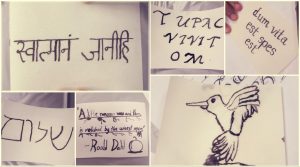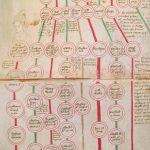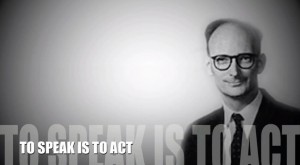Materially-Engaged Pedagogy in the Undergraduate Classroom
As a scholar and teacher, I approach literature from an interdisciplinary perspective that considers how manuscript context, material culture, and religion influence literary production, circulation, and interpretation. To emphasize the integral role of material culture, I design hands-on exercises to explore the tactile, visual, and spatial dimensions of literature and art. I create assignments that ask students to consider the role of material culture in the creation of medieval and early modern literature, to read texts cross-culturally and trans-temporally, and to write textual analyses with careful attention to the rhetorical strategies of their own prose.
Medieval Scribal Practices in the Writing Classroom

Some student creations from the fall 2015 vellum and quills workshop
For my “Medieval Heroes and Monsters” first-year writing course, I received a grant from Emory’s Center for Faculty Development and Excellence for a workshop with vellum and goose feather quills, which functioned alongside a trip to the manuscripts library and an exercise in reading by candlelight. Through reflective writing, students linked the tactile experience of medieval materials to their emerging understanding of their own writing processes as mediated by materials (usually laptops and smartphones rather than quills and ink). This experiential assignment is the basis for an article, “Materially-Engaged Reading in the Writing Classroom” (Pedagogy 19.1, forthcoming 2019), which demonstrates how attention to medieval materiality encourages students to think cross-culturally and to understand their own writing as a long, complex process.
History of the English Language: Book Technologies and Language Change
Throughout my “History of the English Language” course, we analyze manuscripts and printed books for what they reveal about literary production and language change in each period. Students experiment with several book-making technologies about halfway through the semester. In one class session, the material culture workshop helps them understand how the constraints of the manuscript—and subsequently the printing press—influenced the development of the English language. Thanks to a grant from Emory’s Center for Creativity and the Arts, students in my spring 2018 course wrote with quills on vellum, fashioned their own quarto manuscripts, and made collective editorial decisions to set a scene from a Shakespeare play on a make-shift printing press. In a subsequent essay, students analyze and explain the impact of each of these technologies on the way the English language changed during the medieval and early modern periods.
Assignment: Materiality Analysis
A materiality analysis assignment provokes students to consider what size, shape, layout, ink color, language, and other physical and visual features of a codex can tell us about a work of literature before we even read it. Students create this assignment as a public, digital composition on a website, carefully adapting their rhetorical choices to teach a general audience about the interpretative significance of medieval codicological features. The digital, public-facing nature of the materiality analysis requires students to distill complex concepts into an engaging format that any educated reader can understand.
Click here to view students’ materiality analyses from my Fall 2015 first-year writing course. In my upper-division literature course, I adapted the assignment, providing more resources and options for manuscripts; here is a gallery of student work from fall 2017.
Digital Editing Workshops for Graduate Students

Digital Editing and the Medieval Manuscript Roll (DEMMR) is a workshop series, organized and run by graduate students, which uses medieval manuscript rolls to teach the principles of digital editing, XML, and the TEI schema. The creation of a digital version of a manuscript roll, with accompanying searchable transcription and commentary, is the goal of each two-day workshop. With other participants in the March 2016 workshop at Yale University’s Beinecke Library, I contributed a TEI-encoded transcription of a portion of the Middle English text of Osborn MS a14, a late fifteenth-century redaction of John Lydgate’s “The Kings of England sithen William the Conqueror.” I also encoded the instruments of the arma Christi in one of the three large illuminations on Beinecke MS 410, a fifteenth-century prayer and indulgence roll.
I organized a graduate workshop at Emory University for February 27-28, 2018, on the two days prior to the 93rd Annual Meeting of the Medieval Academy of America in Atlanta. My co-instructors for the course were Eric Ensley (Yale University), Gina Hurley (Yale), Elizabeth Hebbard (Indiana University), and Ann Killian (Yale). Following the workshop, I posted a zoomable high resolution image of Emory’s fifteenth-century genealogical chronicle roll on my website, which was digitized for the first time for this project (Emory University; Stuart A. Rose Manuscript, Archives, and Rare Book Library; Ancient, Medieval, and Renaissance Eastern and Western Manuscript Collection; Box 2, Folder 1). The Emory workshop was supported by Emory’s Medieval Studies Program, the Fox Center for Humanistic Inquiry, Program in Linguistics, Department of English, Pitts Theology Library, and Department of History. TEI-encoded editions of all the manuscript rolls mentioned above will be publicly available via Yale’s Beinecke Library website. Please visit the main workshop website for calls for applications for future workshops.
Teaching Resources

A Salvation Diagram in BL Add MS 37049: Transcribed and Translated
I have transcribed and translated the text of the two-page illumination on folios 72v-73r of London, British Library, Additional MS 37049. The fifteenth-century manuscript is a Northern English, Carthusian miscellany, and the two-page illumination could be described as a salvation diagram, as it explains the heavenly or hellish results of earthly religious practices. The image I have captioned depicts the sacraments, several biblical scenes, and the hell mouth; scrolls and banners feature Middle English descriptions of the illuminations. Click here to access the PDF.
 A Speech-Act Theory Adventure
A Speech-Act Theory Adventure
Video project. https://www.youtube.com/watch?v=32Lkl7oUJrQ. Published March 2014. 65,000+ views. Through the video, students learn the definitions of the four key terms in J.L. Austin’s speech-act theory, which provide an opportunity to discuss speech as an act, language as a performance. The video asks students to consider whether or not all language is in fact rhetorical, encouraging students to become aware of the underlying coercive goals of all speech/writing/language. Click here for additional information about the video, including a shot list and an annotated bibliography with materials for teaching with speech-act theory.
